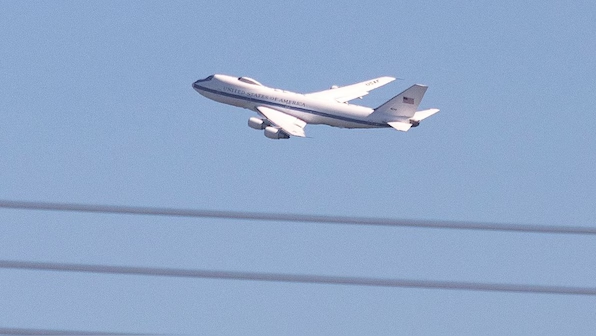The Doomsday Plane has captured global attention this week, sparking curiosity and concern as reports of its movements flood online platforms. Known officially as the Boeing E-4B Nightwatch, this aircraft serves as a flying command center for the U.S. President and top officials during extreme crises, such as nuclear conflicts. Recent real-time news from sources like YouTube and Instagram highlights its rare flight from Louisiana to Washington, D.C., amid escalating tensions in the Middle East. This article dives into what the Doomsday Plane is, its purpose, and the latest developments surrounding its activity as of June 19, 2025.
Understanding the Doomsday Plane’s Role
The Doomsday Plane, or E-4B Nightwatch, is a militarized Boeing 747-200 designed to withstand nuclear blasts, electromagnetic pulses, and cyberattacks. Its primary function is to act as a National Airborne Operations Center (NAOC), ensuring the U.S. government can operate during catastrophic emergencies. Equipped with advanced communication systems, it allows the President or Secretary of Defense to coordinate military actions from the air. The plane features three decks, including a command center, briefing rooms, and 18 bunks for crew rest. With the ability to stay airborne for over 35 hours without landing, it’s a true “Flying Pentagon.”
Recent Instagram posts from aviation enthusiasts show the plane’s distinctive silhouette, fueling speculation about its deployment. Unlike routine military flights, the Doomsday Plane’s movements are rarely publicized, making its recent activity noteworthy.
- Official name: Boeing E-4B Nightwatch
- Purpose: Mobile command post for national emergencies
- Capabilities: Nuclear-resistant, airborne for 35+ hours
- Features: Command center, communication systems, 18 bunks
Why Is the Doomsday Plane in the News?
On June 17, 2025, the Doomsday Plane took a four-hour flight from Barksdale Air Force Base in Louisiana to Joint Base Andrews in Maryland, near Washington, D.C. Real-time tracking on platforms like YouTube, where aviation channels livestream flight paths, revealed an unusual callsign, ORDER01, instead of the typical ORDER6. This sparked online buzz, with users speculating about a priority mission. The timing aligns with heightened tensions between Iran and Israel, raising questions about U.S. preparedness for potential conflict escalation.
News outlets on social media report that the plane’s deployment coincides with President Donald Trump’s strong rhetoric against Iran, including demands for “unconditional surrender.” While no official statement confirms the flight’s purpose, its rarity—last notably used during 9/11—suggests a significant event. The plane’s ability to withstand extreme conditions makes it a critical asset in scenarios involving intercontinental ballistic missile threats.
How Does the Doomsday Plane Operate?
The E-4B Nightwatch is one of four in the U.S. Air Force fleet, each maintained for immediate deployment. Its nuclear shielding and advanced electronics protect against electromagnetic pulses, ensuring uninterrupted communication. Crews train rigorously to operate in high-stakes scenarios, and the plane undergoes regular maintenance to remain mission-ready. Recent YouTube videos from military analysts detail its onboard systems, including secure satellite links and radar-jamming capabilities.
The plane’s recent flight path, tracked by online aviation communities, took an irregular route, adding to speculation. Social media discussions highlight its role as a “flying fortress,” capable of coordinating counterattacks if ground infrastructure is compromised. This capability underscores why its movements draw intense scrutiny.
Public Reaction and Speculation
Online platforms are abuzz with reactions to the Doomsday Plane’s activity. Instagram posts from defense bloggers show clips of the plane landing at Joint Base Andrews, with captions questioning U.S. military intentions. YouTube comment sections are filled with debates, some viewing the flight as routine readiness, others as a signal of impending action. The lack of official clarification fuels these discussions, but the plane’s history of use in major crises keeps the public on edge.
Aviation enthusiasts on social media emphasize the plane’s rarity, noting that spotting an E-4B is a significant event. While some dismiss the hype as overblown, others point to the Middle East’s volatile situation as cause for concern. The Doomsday Plane’s symbolic power as a crisis response tool amplifies its impact on public perception.
What’s Next for the Doomsday Plane?
As tensions in the Middle East persist, the Doomsday Plane’s role remains critical. Its recent flight suggests the U.S. is prioritizing readiness, but whether this indicates imminent action is unclear. Real-time updates on platforms like YouTube and Instagram will likely continue tracking its movements, offering glimpses into military strategy. For now, the plane stands as a reminder of the U.S.’s ability to respond to global threats, even in the worst-case scenarios.
Stay informed by following credible news sources and aviation trackers online. Share your thoughts on social media—what do you think the Doomsday Plane’s recent activity means for global security?
